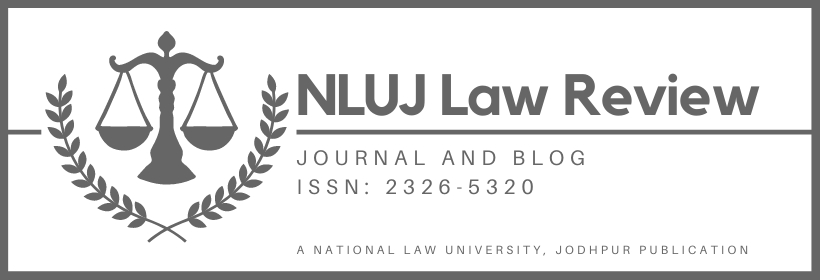Recently, a plea was filed before the Hon’ble Supreme Court to declare that the ‘Constitutional machinery in the State of West Bengal has been broken down’ within the meaning of Article 356 of the Indian Constitution for further consideration of the Hon’ble President. This plea comes in the backdrop of the widespread post-poll violence by the Trinamool Congress (“TMC”) workers that ensued in the state of West Bengal post-TMC’s win in the state assembly elections. The post-poll violence has led many to advocate for imposing President’s rule in the state under Article 356 of the Constitution of India, and the plea, therefore, is symptomatic of the same (flawed) line of thought. These turn of events call for academic scrutiny regarding the provision of Art. 356 itself. While many academics & jurists have suggested amending the article to make it in line with traditional federal principles, not many have advocated for abandoning the said article altogether. It is into this gap that this article attempts to step in and looks at the provision of Article (“Art.”) 356 itself critically and aims to ask and subsequently answer an important but provocative question – whether modern-day India, 70 years post its independence, still, needs such a provision to be part of its Constitution – especially in the provision’s present form?
Looking Beyond Present Judicial Safeguards
Art. 356 empowers the Union to suspend the State Legislature and Executive and impose upon it ‘President’s rule’ when there has been a “failure of constitutional machinery” in the State. It helps in constituting a strong centre and often aids the Union in acting like a big brother running against traditional federal principles, impacting the entire federal fabric of the country more often than not in a negative fashion. This peculiar power granted by Art. 356 to the President appears to = treat the state legislature, which is as much an elected body as the parliament, as mere delegates or agents of the Central government, and hence, naturally, it raises a serious question regarding federalism which forms the basis of our Constitution.[i]
However, the Indian Supreme Court, from time to time, has stepped in to keep a check on the power conferred upon the Union under Art. 356. One such example is the landmark decision given by a nine-judge bench in the SR Bommai case, which has undoubtedly done a great deal in sharply limiting the constitutional power granted by Art. 356, by carving out the necessary checks.[ii] The positive effect that Bommai has had on the constitutional and political landscape clearly emerges out if one looks at the time-period 15 years prior to Bommai, i.e., before 1994 in which Art. 356 was invoked 40 times while on the other hand 15 years post-Bommai in whichit was only invoked 11 times. However, it has been argued that Art. 356 is symptomatic of a problem that requires a judicial fix beyond what was laid down in SR Bommai.
The Union has often taken advantage of Art. 356 to pluck holes in the federal character of our country. It has often been seen that the recommendation under Art. 356 given by the cabinet to the President is politically coloured, palpably unconstitutional and arbitrary on the face of it and not because there has been a “failure of constitutional machinery” in the state. For example, in the Sarkaria Commission Report, it was observed that only in 26 out of the 75 cases of imposition of President’s Rule until then, the President’s rule was inevitable and therefore justified. Unfortunately, this trend has lingered and haunted the Indian political landscape even post the Sarkaria Commission Report, and the present debate on whether or not to impose President’s rule in the state of West Bengal is just another example.
Evolving The ‘Last-resort’ Doctrine
It has been held in multiple cases that Art. 356 must be imposed only as a matter of ‘last resort’.[iii] The last-resort doctrine is a useful one and is based on the notion that when the President imposes Art. 356, he creates a situation that is not remediable; a fait accompli and, therefore, such exceptional powers must be used as a matter of last resort. However, this has seldom deterred the Union from imposing Art. 356 in a particular state. They have, more often than not, used Art. 356 as a ‘first instinct’ rather than as a ‘last resort’.
The last-resort doctrine shakily stands on having immense faith in the Union to do the right thing. This is because the Court traces the reasoning behind using Art. 356 as a last resort to Dr. Ambedkar’s optimistic hope of Art. 356 “never being called into operation and being a dead letter”. It also finds support in the Sarkaria Commission Report, which adopts a similar view suggesting that Art. 356 should be used sparingly and only when “all available alternatives have failed to prevent or rectify the break-down of the Constitutional Machinery”.
However, there is room for interpreting and evolving this last-resort doctrine into something much more robust and more prone to be followed by the Union so that this doctrine is fortified and acts as a strict deterrent for the Union and not just as a minor inconvenience. The Court can lay down proper guidelines that are needed to prove that all other alternative remedies were exhausted before imposing Art. 356. This would include demonstrating that analogous provisions which are complementary in nature like Art. 355, which impose a Constitutional duty on the “Union to ensure that the Government of every State is functioning in accordance with the Constitution”, are used before resorting to Art. 356. Art. 355 has the capability of standing on its own, and the Union is well within its power to issue a proclamation under Art. 355 without resorting to imposing a President’s rule.[iv] This argument stands on the notion that the Union Government should not penalise the State Government before performing its own Constitutional duty under Art. 355.[v]
The Union Government must also strictly use other remedies like issuing directions to the State, who is erring under Arts. 256 & 257 to properly enforce the Union and State Laws. Only if the State fails to comply with these directions, Art. 365 can be invoked first. This allows the President to hold that “a situation has arisen in which the state government cannot be carried in accordance with the provisions of the Constitution”. Therefore, only in this eventuality under Art. 365 first, a case to issue President’s rule under Art. 356 may be made. The aim shall be to overcome a contingency without resorting to the hammer of Art. 356 and exploring all the possible avenues first.
While, in theory, the last-resort doctrine may appear to include under its ambit exploring these possible avenues first, in practice, the Union rarely takes it seriously as it is not expressly bound by it. The last-resort remedy that the Sarkaria Commission Report gives in order to treat the disease of Art. 356, faultily relies on the hope of the constitution-makers that there would be a growth of healthy conventions which would ensure that these powers are used sparingly. It therefore optimistically hopes for a ‘constitutional culture’ to develop which would compel the Union to treat these conventions with the same amount of respect as if they were a Constitutional provision.[vi] However, this is certainly not what has happened, and the Indian political experience has shown us a different picture of how Art. 356 has been (mis)used.
Looking at Article 356 Critically
Such a form of unilateral action by the Union to subvert the federal system as under Art. 356 has no precedent in any modern-day federal Constitution.[vii] Naturally, the question arises whether the provision of Art. 356 was even required in the first place, and whether Modern-day India, 70 years post its independence, still needs such a provision to be part of its Constitution. The Uttarakhand High Court, in the recent case of Harish Chandra Rawat v. Union of India, in paragraph 45 of the judgement, observed that Art. 356 was a ”foray into the pure form of federalism” because ideally, in a pure form of federalism like that of the United States of America, there would be no power for the Union to interfere in the affairs of the State Government whatsoever. This came as an important observation as the Bench doubted the legitimacy of Art. 356 itself. However, in the next line itself, it lethargically justified the provision stating that since “our founding fathers in their wisdom” deemed fit to have this provision, it should not be questioned.
This originalist approach, as opposed to a transformative constitutional one, is quite flawed as the circumstances and situations that a country goes through never remain static. The circumstances and considerations when the Constituent Assembly was drafting the Constitution were quite different from what they are today. For example, the idea of a ‘strong centre’ came from the justifiable anxieties of the national leaders in a post-partition India in which their inevitable reaction was to prevent further fragmentation of the nation due to regional and communal forces.[viii] Therefore, as was also argued by N.V. Gadgil in the Constituent Assembly, a strong Centre was an “imperative necessity”.[ix]
It is with this post-partition anxiety that Constituent Assembly members defended Art. 356 by pointing out the need for a provision that could tackle nefarious political forces like communists among other ‘menaces’ , who could come to power in the States through the ballot boxes and then try to subvert constitutional democracy itself. Algu Rai Sastri used this very defence of Art. 356 in the Constituent Assembly and pointed out the then situation in Bengal, Madras and Hyderabad where there existed some ‘anti-social’ elements trying to uproot the Government of the Province and situations like these, he argued, might call for an immediate intervention by way of using Art. 356.
However, this line of argument cannot have any place in the present-day Indian political scenario as we are now relieved of the post-partition anxieties, to a certain extent, that our founding fathers had to face. Additionally, the argument that just because the Union deems certain groups as ‘anti-social’ elements (which are often political groups with opposite ideologies) present in a State, the Union should be allowed to eat into the vitals of a regular federal system, has no moral legs to stand on in Present-day India and needs critical reconsideration.
Concluding Remarks
Art. 356 and its analogous provisions have been invoked 111 times[x], and hence it has been called a provision which is over a ‘100 blows old’ and a hammer that all Governments love. Even though there has been judicial check to the misuse of Art. 356 by way of judgements like S. R. Bommai, the article’s use is still not according to the expectations of how our ever so optimistic Founding Fathers envisaged the Union to behave. H.M. Seervai has argued that the powers conferred by Art. 356 “have been gravely abused”, and that to prevent or minimize such misuse and abuse, constitutional amendments would be necessary and would inevitably have to be made at some point.[xi]
Art. 356 has been termed as “an unhappy legacy from the British rule” and represents an extreme power in the hands of the Union which, if implemented and exercised, has the potential to “destroy the constitutional equilibrium between the Union and the State”.[xii] Hence, a very radical idea to stop this constitutionally backed assault on federalism and, in turn, strengthen the federal character of this country would be for us to take a rather critical view of the existence of Art. 356 in our Constitution itself, looking at the absence of such a provision in other federal Constitutions and the changing times from what India was going through 70 years ago to what it is today.
[i] Ashok Desai, ‘Emergency Provision’ in M. Hidayatullah (ed.), Constitutional Law of India, vol. 2 (Bar Council of India Trust, 1984) 665. (Desai)
[ii] K. Suryaprasad, ‘Judicial Review of the Presidential Proclamation under Art. 356 of the Constitution of India: A critical Analysis’ (1999) 33(1-4) Journal of Constitutional and Parliamentary Studies 60.
[iii] See S.R. Bommai v. Union of India (1994) 3 SCC 1; In The Matter of Special Reference No. 1 of 2002 (2002) 8 SCC 237; Rameshwar Prasad (VI) v. Union of India (2006) 2 SCC 1.
[iv] Durga Das Basu, Commentary on the Constitution of India, vol. 14 (9th edn, LexisNexis, 2019) 15178.
[v] Durga Das Basu, Comparative Federalism (2nd edn, LexisNexis 2008) 323; cf B.R. Ambedkar, CAD, vol. XI at 133-34. (Basu)
[vi] Basu (n 4) 15179.
[vii] William O. Douglas, We the Judges: Studies in American and Indian Constitutional Law from Marshall to Mukherjea (Doubleday & Co 1956) 20-21.
[viii] Basu (n 4) 117,
[ix] N.V. Gadgil, CAD, vol. XI, p.657-58.
[x] Basu (n 4)15178.
[xi] H.M. Seervai, Constitutional Law of India, vol. 1 (Universal Law Publishing, 2014) 294. (emphasis added)
[xii] Desai (n 1) 665.
This article has been written by Aman Mehta, student at Jindal Global Law School, Haryana.



